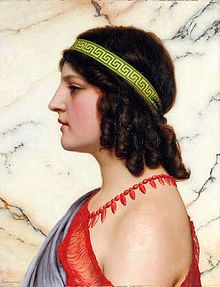Praxilla's predecessor was the great poetess Sappho of Lesbos and her contemporary was Telesilla of Argos. All of them are important representatives of female lyric poetry of the Archaic period. In later periods, ranging from the 4th century up to the Hellenistic and Roman times, we can find other poetesses such as Erinna of Telos, Anyte of Tegea, Myro of Byzantium, Nossis, Aristodama of Smyrna, or Melinno.

Praxilla of Sicyon
Entre 550 y 450 a. e. c.; n. Sicyon, Greece
Periodo de actividad: 535 a. e. c. — 400 a. e. c.
Clasificación geográfica: Europa > Grecia
Movimientos socio-culturales
Antigüedad > Cultura griega > Época arcaica
Grupos por ámbito de dedicación
Escritoras > Poetas
Escritoras > en > griego (antiguo)
Contexto de creación femenina
Reseña
Praxila is, along with Sappho, Telesila of Argos and many other women poets of ancient Greece, a representative of women's poetry within the framework of archaic lyric poetry. She invented a new dactylic metre, the praxillium, and was highly valued and well-known: her poems were sung until the 2nd century BC. Praxila, along with Sappho and Telesila, together with Erina of Telos, Corina of Tanagra, Mirtis and Nosis, is mentioned in an epigram by Antipater of Thessalonica, which constitutes the first "canon" of female lyric poetry and, like all of them, inspired later poets, such as Theocritus and Catullus.
Actividades
Justificaciones
Biografía
Praxilla was a 5th century BC Greek poetess from Sicyon.
A Greek poet of the 1st century AD, Antipater of Thessalonica, places her first in his list of the nine "immortal-tongued" female poets. She was highly valued in her time. Proof of this is that a famous sculptor, Lysippus, made a bronze statue of her. In addition, a piece of ceramic was found with the first four words of one of her poems. Further proof of the reception of her work in the 5th century BC comes from the playwright Aristophanes, who parodied lines of her poetry in both Wasps (v. 1238) as in Women at the Tesmophoria (v. 528). It is not just that he was aware of her work, but his parody implies that he expected his Athenian audience to recognise it as well.
Only eight fragments of her work are preserved. She wrote banquet songs, hymns, and dithyrambs (choral odes performed at the festivals of Dionysus). She also composed a hymn to Adonis a fragment of which is preserved.
It is difficult to assess Praxilla's work, given the small volume of it that is preserved, but her poems were sung until the 2nd century BC. She invented a dactylic metre known as Praxilleion and inspired later poets such as Theocritus and Catullus.
Obras
- 3 fragmentos (escolios) / 2 himnos: Aquiles, Adonis en el inframundo (obra fragmentaria). [es] [en] [cat]
Bibliografía
-AAVV (1980) Lírica griega arcaica (poemas corales y monódicos, 700-300 a.C.), Madrid. Ed. Gredos
-Luque, Aurora (2020) Grecorromanas. Lírica superviviente de la Antigüedad clásica. Ed. Austral, (consultado el 07/052021).
-Rivas, Robert (2013). “Los fragmentos de Praxila”, en Idiomas olvidados, (Retrieved on 07/05/2021) , <Idiomas olvidados: LOS FRAGMENTOS DE PRAXILLA (inutilesmisterios.blogspot.com) >
-Rodríguez Somolinos Helena; Bernabé Pajares, Alberto (1994) Antología Palatina, Poetisas griegas. Madrid: Ediciones Clásicas, (Retrieved on 07/05/2021), <https://es.scribd.com/document/389711443/Antologia-Palatina-Poetisas-Griegas-pdf>
Enfoque Didáctico
-Classical culture: Block Classical roots of today's world. Everyday life; Block Continuity of cultural heritage. Literature (Poetry), art and science.
-Greek Baccalaureate: Block The text: comprehension and translation; Block Literary education.
-Spanish Language and Literature ESO: Literary Education Block.
-Universal Literature 1st Baccalaureate: Interpretation of Greek period fragments of different genres and themes.